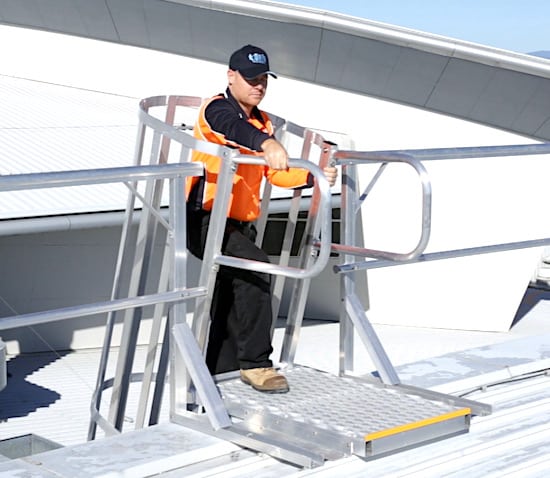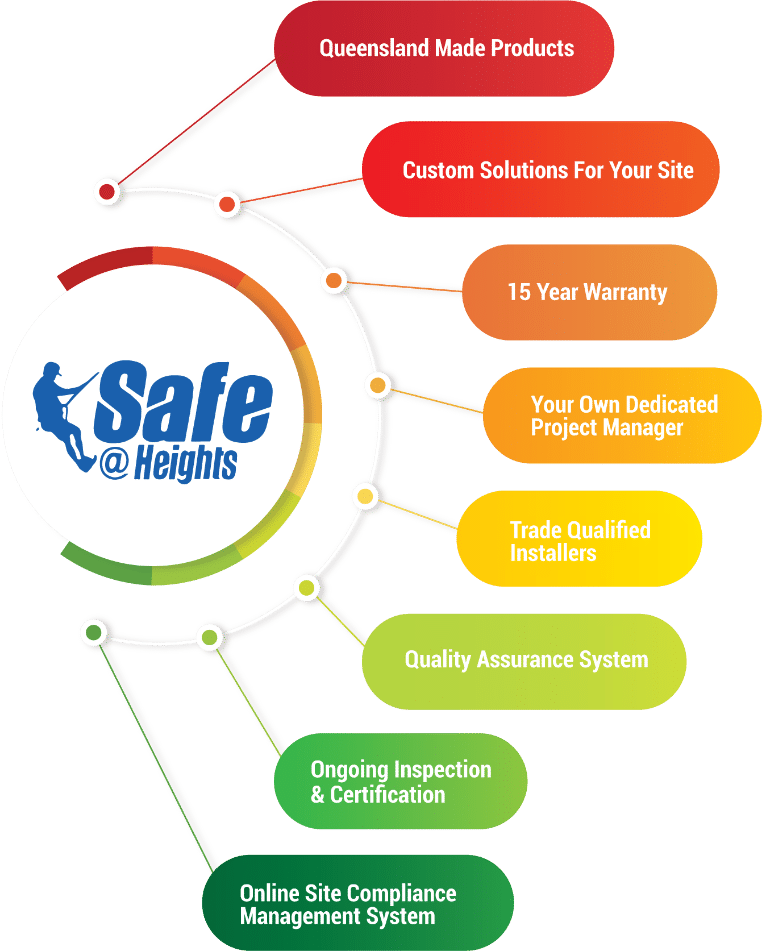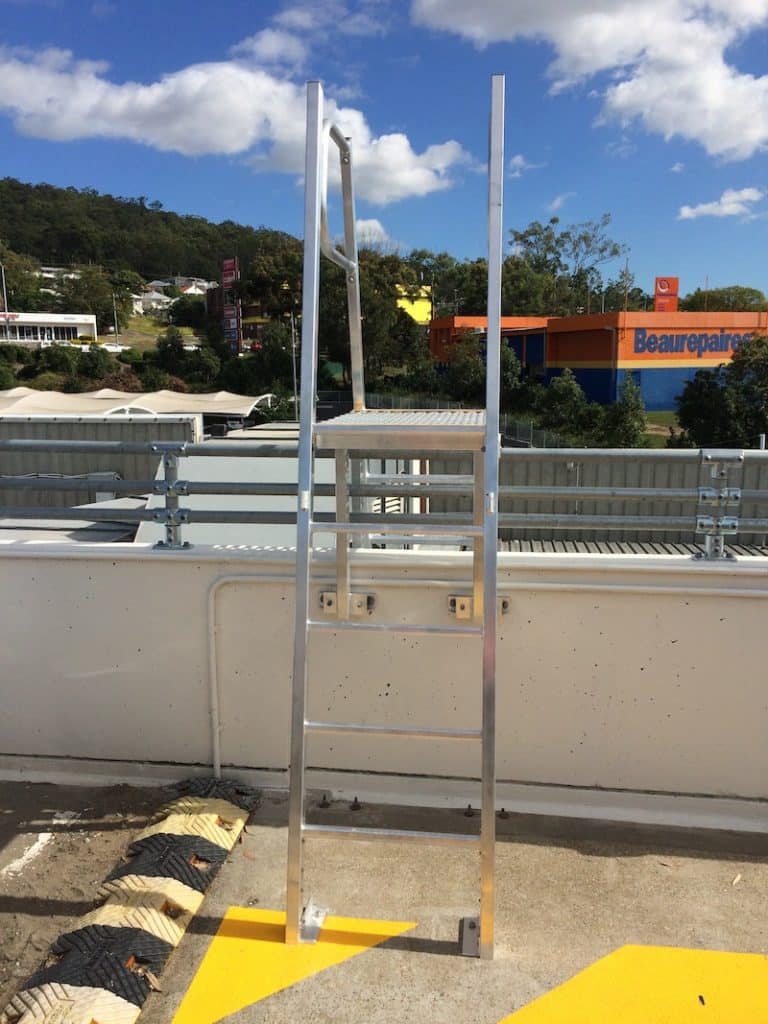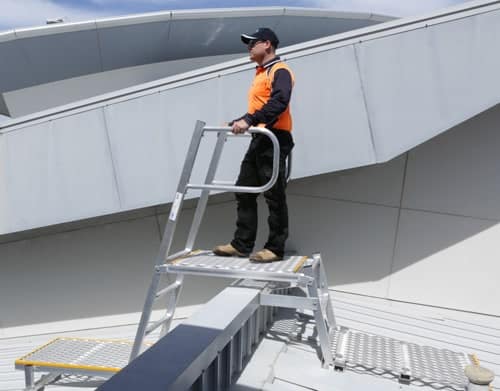Choose our Angled Rung Ladders, your gateway to safer, efficient access in various work environments.
ANGLED RUNG LADDERS
Our Queensland Designed and Made range of ladders are the perfect solution for safely accessing your roof. All our ladders come with our industry leading 15 year warranty when part of our Certification & Safety Program.
We can design, fabricate and install a custom made angled rung ladder that will perfectly suit your site and access requirements. All of our ladders are designed and comply with AS1657:2018 and are made from high-quality marine-grade aluminium. Depending upon the area you need to access, the design can take many forms. That is why it is important to speak with one of our height safety specialists who are able to advise you on what would be most appropriate for the location and reason for use. To find out more about our angled rung ladders or to speak to one of our design specialists please contact us.
Learn More About Angled Rung Ladders

An angled rung ladder must comply with the design guidelines as set out in AS1657:2018. This is the most common ladder you will see at a work site or on the roof of a building. An angled rung ladder is considered the 5th option of the preferred access options as specified in Section 2 – Means of Access in AS1657:2018. This section states:
An angled rung ladder must comply with the design guidelines as set out in AS1657:2018. This is the most common ladder you will see at a work site or on the roof of a building. An angled rung ladder is considered the 5th option of the preferred access options as specified in Section 2 – Means of Access in AS1657:2018. This section states:
“There shall be a means of access and egress to all the zones and points where the need for access for operating, inspection, maintenance and servicing equipment can be foreseen.” It then goes on in section 2.2 to state, “The means of access shall be selected from the following list and considered in the hierarchical order given:
- Level walkway (0° to 3° from the horizontal)
- Sloping walkway with an angle between 3° and 20° in the direction of travel
- Stairs with an angle between 20° and 45°
- Inclined step-type ladders with an angle between 60° and 70°
- Inclined twin-stile rung-type ladders with an angle between 70° and 90° (This is an angled ladder)
- Single stile rung ladders with an angle between 85° and 90°
- Individual rung ladders (step-irons) with an angle between 80° and 90°
Directly under this section has additional information under the heading of Notes. One of those notes directs the reader to Appendix G for further information on selecting the most appropriate means of access. In the Appendix AS1657:2018 provides further guidelines that should be followed when considering if an angled rung ladder is appropriate. Section G4 .1 states that selecting a ladder instead of walkway or stairs as a permanent means of access should be avoided wherever possible due to the greater risk of falling, the greater physical effort required to climb and the restrictions imposed on carrying tools and equipment. It goes on to provide 6 reasons where a rung ladder would be considered appropriate and states that at least two of these conditions need to be met before the use of a rung ladder could be considered appropriate. The 6 conditions are:
- Infrequent use of the ladder is foreseen
- The users of the ladder would not be carrying tools or other equipment
- Only one user will be likely to be using the ladder at one time
- The ladder is not intended to be used to evacuate injured persons
- The structure does not allow stairs or other types of access
- The ladder is only to be used for access to and from an area and not for carrying out actual works
As a summary to the above, AS1657:2018 allows for the installation of an angled rung ladder where walkways, stairs or step type ladders are not able to be installed and provides 6 conditions that must be considered when designing access.
In addition to AS1657:2018, designers of access from one level to another must consider the guidelines provided in the Managing the Risk of Falls at Workplaces Code of Practice. In particular the section on Fixed Ladders, which provides more detail about risk and what other factors should be considered. This Code of Practice is an approved code under section 274 of the Work Health and Safety Act. Within the Forward of the Code it states why the code must be followed and how it should be used. It states,
“An approved code of practice is a practical guide to achieving the standards of health, safety and welfare required under the WHS Act and the WHS Regulations……A code of practice applies to anyone who has a duty of care in the circumstances described in the code. In most cases, following an approved code of practice would achieve compliance with the health and safety duties in the WHS Act…..Codes of practice are admissible in court proceedings under the WHS Act and WHS Regulations. Courts may regard a code of practice as evidence of what is known about a hazard, risk or control and may rely on the code in determining what is reasonably practicable in the circumstances to which the code relates.”
Due to this, we regard complying with this code for our designs to be vitally important. The start of the fixed ladder section of this code states that all ladders should comply with AS1657. In addition to this it goes on to state that where possible all angled ladders should be at an angle of no less than 70° and no more than 75°. This is why our recommendation is that where it has been found appropriate to install an angled ladder, that it is installed at an angle between 70° and 75°. As a general rule we install our ladders at 75°. We feel this angle is most suited to the angled ladder.
In addition to the angle there are other considerations such as,
- Leveled platforms
- P rails
- Cages
- Edge protection
It is all of these elements that we will take into consideration when designing safe access from one level to another for your site.
For further information about our angled rung ladders, our designs, custom fabrication or installations please do not hesitate to contact us.

Companies we have proudly worked with











Request a Quote
Get in touch










